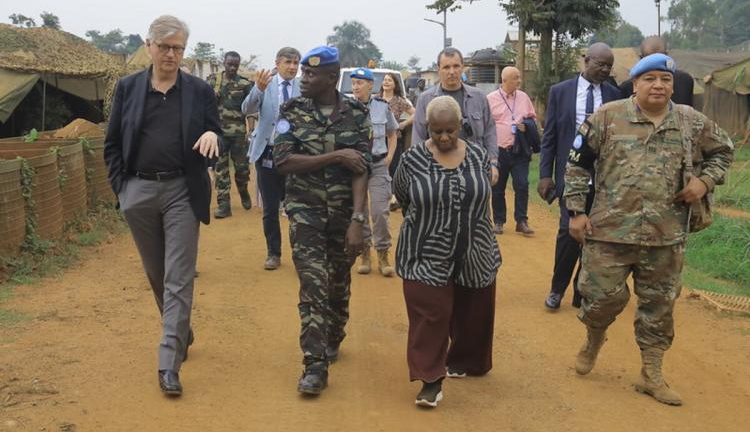By Manuel Wollschläger
The Under-Secretary-General for UN Peace Operations, Jean-Pierre Lacroix (left), visited on 13 February the eastern part of DR Congo, with stops in Goma, Beni and Bukavu. Photo: MONUSCOW
The IPS-Journal published the following article on 16 February. The author is the Head of the Friedrich-Ebert-Stiftung’s office in the Democratic Republic of Congo.
BERLIN | 25 February 2024 (IDN) — Congolese defence minister Jean Pierre Bemba is determined: everything possible is being done to prevent the provincial capital Goma from falling into the hands of the rebel March 23 Movement (M23).

However, the military clout of M23, which a UN expert group says is backed by Rwanda, should not be underestimated. It has already taken Goma once before, in 2012. Its main complaint back then was the failure to keep the promises made in the peace agreement struck on 23 March 2009. The integration of the rebel groups primarily representing the interests of the Tutsi minority had not been successful. On that occasion, however, the city was rapidly retaken in cooperation with MONUSCO, the UN peace mission, and the rebels forced into exile.
Ten years later—in March 2022—M23 once again crossed the border in the area where Uganda, Rwanda and the Democratic Republic of Congo meet and occupied broad swathes of the Rutshuru and Masisi Territories in the Congolese province of North Kivu. UN Secretary-General Antonio Guterres acknowledged that the Blue Helmet mission MONUSCO stationed in the Congo was not sufficiently armed to be able to halt the advance.
In response to the ongoing conflict, the Congolese parliament imposed martial law in North Kivu. A military commander has been standing in for the governor for more than a year now. What is worrying in this situation is that MONUSCO’s peacekeeping mission is to be gradually phased out by the end of 2024 due to its inefficiency and at the request of the Congolese government. There had previously been an increase in violent attacks by the population against UN soldiers. In over 20 years the Blue Helmets have been unable to put a lid on the simmering conflict and protect the civilian population against the many foreign and local militias active in the country.
Fighting fire with fire
This conflict in the east of the Democratic Republic of Congo has a long history. The second Congo war led to a Blue Helmet deployment in 1999. Uganda and Rwanda were fighting on Congolese soil against rebel groups from neighbouring countries and the Congolese army. The population tried to protect itself by forming Mai-Mai militias. In addition, foreign and domestic troops were competing for control of the region’s major natural resource deposits. This formed the basis later on for the inclusion of due diligence obligations in supply chains, with a view to ending the illegal trade in gold and other minerals. MONUSCO’s presence enabled humanitarian actors at least to do something to ameliorate the catastrophic conditions afflicting the swell of internal refugees displaced by the conflict.
A ceasefire was negotiated with M23 last December, under US pressure. It lasted only ten days. Previously, peace negotiations had been urged by the East African Community (EAC) and the International Conference on the Great Lakes Region (ICGLR). Last year the EAC sent troops, but withdrew them again after a few months, having failed to achieve anything. Shortly before Christmas a regional military mission (SAMIDRC) was dispatched, this time under the leadership of the Southern African Development Community (SADC). It remains to be seen whether the soldiers from Tanzania, Malawi and South Africa, with a more robust mandate, will be able to turn things around.
The Congolese army, the FARDC, had recently stationed attack drones in the region, but it is grossly underfunded, poorly armed and in the past has repeatedly been accused of abusing the civilian population. UN Under-Secretary-General for Peace Operations Jean Pierre Lacroix now signalled his willingness to support SAMIDRC, but noted that the Security Council would have to adapt the mandate accordingly. Cooperation with the Congolese had already been stepped up last year with Operation Springbok to defend against the rebels.
Local militias—so-called Wazalendos (‘Patriots’)—similar to the Mai-Mai movements, have been forming in many places to resist M23’s advances. The deployment of these unsupervised units, however, is risky because they are scarcely neutral. Similarly, there are reports of Romanian mercenaries in the region, which the Congolese government has been using primarily to guard the airport at Goma.
Any chance of a negotiated solution appears elusive. President Félix Tshisekedi, re-elected with an overwhelming majority at the end of 2023, has repeatedly insisted that talks with M23 are absolutely out of the question and has not ruled out declaring war on Rwanda. Rwanda, in turn, argues that the Congolese FARDC is in league with Interhamwe paramilitaries, who fled to Congo during Operation Turquoise following the Rwandan genocide in 1994, where they founded the rebel group the Democratic Forces for the Liberation of Rwanda (FDLR). M23 is regarded as a Congolese Tutsi group and any interference by the Rwandan army is denied.
Talking past each other
A wave of patriotism has swept the country. Recognition is dawning that international peace missions are no solution to the ongoing conflict. Sovereignty is repeatedly being invoked. The Congolese people need to take their fate into their own hands. Before the quarter-final of the African Cup of Nations, Congolese players tried to draw attention to the dreadful situation in eastern Congo. Canal+ faced a backlash in Kinshasa for allegedly avoiding camera shots of Congolese fans’ placards and banners during the match broadcast. Demonstrators also gathered in front of Western embassies again at the weekend. Cars and tires were burned in protest.
As early as last August the EU imposed sanctions on both Congolese and Rwandan actors for serious human rights violations. The United States has also repeatedly called for a cessation of hostilities. The Congolese side, however, has condemned Western hypocrisy as close relations with Rwanda have not suffered despite their involvement in the conflict.
Fighting has broken out again in the past few days around Sake, only a few kilometres from Goma. The famous ‘Amani Festival’, scheduled for 16-18 February, was called off at the last minute after two bomb blasts in Goma.
According to the UN, the number of displaced persons nationwide has now reached 6.29 million. The most recent clashes drove another 135,000 people to Goma. Humanitarian organisations have condemned the precarious conditions in the refugee camps. They have been trying for decades to relieve the suffering in the disputed areas. The food situation and lack of sanitation to which refugees are exposed are alarming.
Besides the continuing pressure on the conflicting parties to cease hostilities and resume dialogue, the international community, together with the Democratic Republic of Congo, should find a solution that disarms the numerous rebel movements and reintegrates them into civilian life. To have any chance of success the population has to be involved. Previous approaches have made little progress. The current PDDRCS demobilisation programme is trying to take account of this, but it lacks resources and is thus being implemented very slowly and patchily.
Establishing authority based on the rule of law is often a challenge in remote areas. But it must be the foundation of any sustainable protection of the civilian population. Otherwise, when MONUSCO withdraws, humanitarian aid and development projects may cease because the Blue Helmets also provide logistical capacities alongside protective convoys and patrols.
It is doubtful that the Congolese army and police will be able to assume these tasks as early as next year. An orderly transition is therefore optimal, possibly extending beyond 2024. The deployment of regional peacekeeping troops still needs to prove itself under the current conditions. The dispatch of 2,900 South African soldiers by the SADC is a first step in this direction. [IDN-InDepthNews]
Photo: The Under-Secretary-General for UN Peace Operations, Jean-Pierre Lacroix (left), visited on 13 February the eastern part of DR Congo, with stops in Goma, Beni and Bukavu. Photo: MONUSCO
IDN is the flagship agency of the Non-profit International Press Syndicate.


